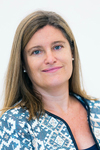News
AI helps bring clarity to LASIK patients facing cataract surgery
Wednesday, September 20, 2023
Scientists develop computer models of patients’ eyes to identify the ideal intraocular lenses and visual simulators for patients to experience how they will see with them
While millions of people have undergone LASIK eye surgery since it became commercially available in 1989, patients sometimes develop cataracts later in life and require new corrective lenses to be implanted in their eyes. With an increasing number of intraocular lens options becoming available, scientists have developed computational simulations to help patients and surgeons see the best options.
In a study in the Journal of Cataracts & Refractive Surgery, researchers from the University of Rochester created computational eye models that included the corneas of post-LASIK surgery patients and studied how standard intraocular lenses and lenses designed to increase depth of focus performed in operated eyes. Susana Marcos, the David R. Williams Director of the Center for Visual Science and the Nicholas George Professor of Optics and of Ophthalmology at Rochester, says the computational models that use anatomical information of the patient’s eye provide surgeons with important guidance on the expected optical quality post-operatively.
“Currently the only pre-operative data used to select the lens is essentially the length and curvature of the cornea,” says Marcos, a coauthor of the study. “This new technology allows us to reconstruct the eye in three dimensions, providing us the entire topography of the cornea and crystalline lens, where the intraocular lens is implanted. When you have all this three-dimensional information, you’re in a much better position to select the lens that will produce the best image at the retinal plane.”
Read More: AI helps bring clarity to LASIK patients facing cataract surgerySusana Marcos recognized at Spain’s Smart Woman Forum & Awards
Wednesday, August 9, 2023
Susana Marcos, the David R. Williams Director of the Center for Visual Science and the Nicholas George Professor of Optics and of Ophthalmology, was recognized with an award for best investigator by Spain’s Federation of Health Innovation Industry. She was recognized at the Smart Woman Forum & Awards in Madrid on July 19.
Marcos is an internationally recognized expert in the optics of the eye and the interactions of light with the retina. Her lab aims to understand the interplay of structural, biomechanical, and optical properties of the eye, their impact on retinal image quality, and the limits they impose to visual function and perception.
Susana Marcos Awarded the Edwin H. Land Medal
Thursday, April 6, 2023
 WASHINGTON – Optica (formerly OSA), Advancing Optics and Photonics Worldwide, and the Society for Imaging Science and Technology (IS&T) are pleased to announce that Susana Marcos, the David R. Williams Director of the Center for Visual Science, University of Rochester, USA, has been awarded the Edwin H. Land Medal. Marcos, a highly regarded researcher in the field of visual optics and ocular imaging, is a pioneer in the development of new techniques for the evaluation of the eye. Her work is aimed at understanding the interplay of structural, biomechanical and optical properties of the eye. Marcos studies the impact of those properties on retinal image quality, and the limits that optics impose on visual functions and perception, specifically with applications in myopia, presbyopia, cataract and corneal corrections.
WASHINGTON – Optica (formerly OSA), Advancing Optics and Photonics Worldwide, and the Society for Imaging Science and Technology (IS&T) are pleased to announce that Susana Marcos, the David R. Williams Director of the Center for Visual Science, University of Rochester, USA, has been awarded the Edwin H. Land Medal. Marcos, a highly regarded researcher in the field of visual optics and ocular imaging, is a pioneer in the development of new techniques for the evaluation of the eye. Her work is aimed at understanding the interplay of structural, biomechanical and optical properties of the eye. Marcos studies the impact of those properties on retinal image quality, and the limits that optics impose on visual functions and perception, specifically with applications in myopia, presbyopia, cataract and corneal corrections.
"On behalf of the Optica Board and membership, I am proud to congratulate Susana Marcos for this recognition," said Michal Lipson, Optica's 2023 President. "The Land Medal is awarded to individuals who share in Edwin Land's insatiable scientific intensity and curiosity in optics and imaging and, in part, reflect his image as inventor, scientist, entrepreneur, and teacher. Susana’s career journey in eye diagnostics and treatment reflects her impressive impact on the ophthalmic industry.”
Marcos joined the University of Rochester faculty in 2021 after serving as Director of the Institute of Optics, CSIC, Spain, (IO-CSIC), and Professor of Research at CSIC, where she founded the Visual Optics and Biophonics Lab (VIOBIO) in 2000. Marcos is a Fellow of Optica, the European Optical Society, and the Association for Research in Vision Ophthalmology. Marcos’ research recognitions include the Adolph Lomb Medal (Optica), ICO Prize, Doctor Honoris Causa (Ukraine Academy of Science), Ramón y Cajal Medal (Royal Academy of Sciences), King Jaime I Award, and National Research Award in Engineering.
Marcos is a cofounder of 2EyesVision SL and a coinventor of the SimVis technology that allows patients to ‘try on’ multifocal corrections before putting in contact lenses or having an intraocular lens implantation. She has authored or coauthored more than 200 peer-reviewed papers in top journals and has 23 patents (14 licensed to industry).
About the Edwin H. Land Medal
Recognizing pioneering work empowered by scientific research to create inventions, technologies, and products, the Edwin H. Land Medal was established in 1992 to honor his unique career as a scientist, technologist, industrialist, humanist and public servant. It is jointly presented by Optica and the Society for Imaging Science and Technology (IS&T) and is funded through the support of the Polaroid Foundation, the Polaroid Retirees Association and individual contributors, including Manfred Heiting, Theodore Voss and John J. McCann.
Read More: Susana Marcos Awarded the Edwin H. Land Medal